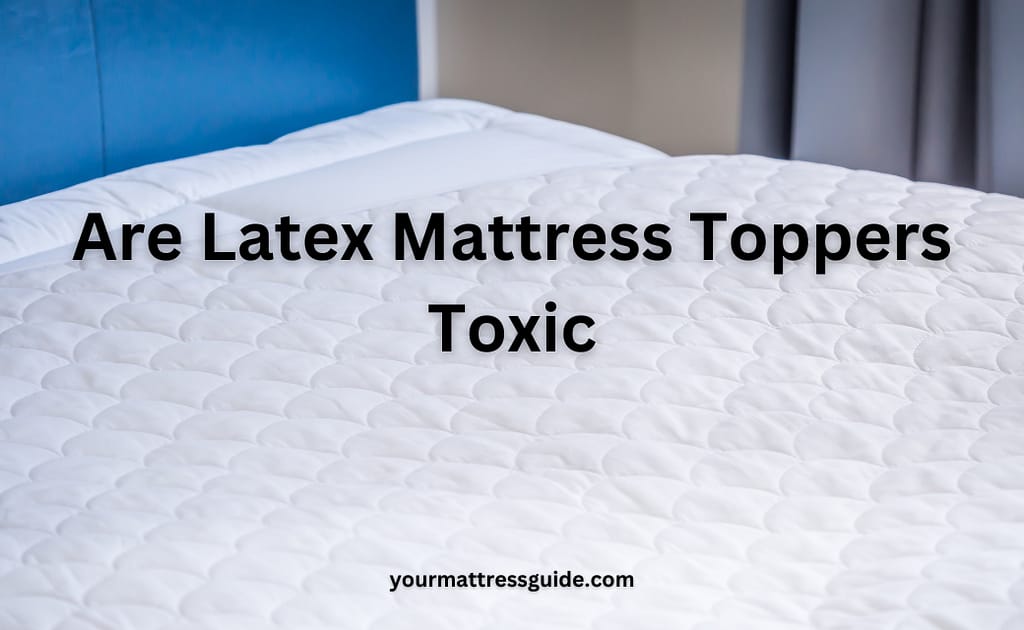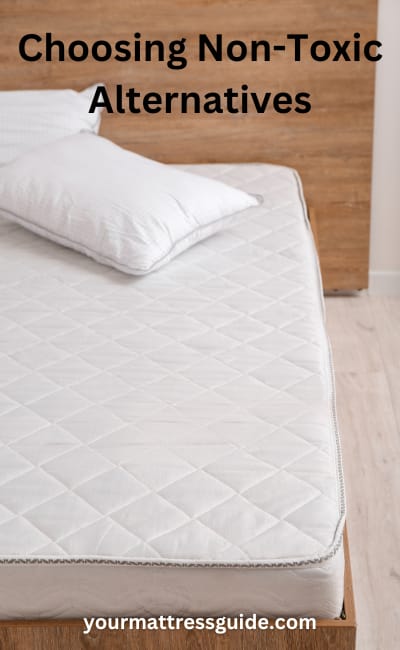Many people are concerned about the chemicals and off-gassing associated with certain bedding products. This article will explore the question, ‘Are latex mattress toppers toxic?‘
Latex, a natural material derived from the sap of rubber trees, is often praised for its comfort and durability. However, it’s essential to understand the potential risks and health concerns associated with latex toppers.
Some latex products may contain harmful chemicals that can off-gas and affect indoor air quality.
Don’t fret! We will also discuss non-toxic alternatives that you can consider. Whether you’re concerned about allergies, environmental impact, or simply want a healthier sleep environment, options are available.
Lastly, we will provide tips for the safe use and maintenance of latex mattress toppers, helping you make an informed decision and ensuring a comfortable and worry-free sleep experience.
So, let’s dive in and learn more about latex mattress toppers and their potential toxicity.

What Are Latex Materials?
Imagine sinking into a luxurious, cloud-like latex mattress topper that gently cradles your body, providing unparalleled comfort and support. Latex mattress toppers come from natural or synthetic latex derived from rubber tree sap.
Are latex mattress toppers toxic? It depends on the materials your bedding company uses. Natural latex is famous for its hypoallergenic properties and resilience, making it a popular choice for those seeking a healthy, eco-friendly bedding option.
On the other hand, synthetic latex comes from petroleum-based chemicals may contain potentially harmful substances such as VOCs (volatile organic compounds).
It is important to note that not all latex mattress toppers are toxic. To ensure you purchase a safe and non-toxic product, look for certifications such as OEKO-TEX Standard 100 or GOLS (Global Organic Latex Standard), which guarantee the absence of harmful substances. Also, check our article on Are Roll Up Mattresses Any Good
Potential Off-Gassing of Latex Toppers
While some concerns have been raised about potential emissions, it’s essential to consider the off-gassing aspect of latex toppers. Latex itself is a natural material and doesn’t typically emit harmful chemicals. However, there are a few things to keep in mind:
- Freshly manufactured latex toppers may have a slight odor, which is temporary and will dissipate over time.
- Look for latex toppers certified by independent organizations, such as OEKO-TEX or GOLS, to ensure they meet safety standards.
- Proper room ventilation can help speed up the off-gassing process and minimize any potential odors.
- If you are sensitive to smells or chemicals, consider airing out the latex topper before use or opting for a mattress topper made of alternative materials.
Considering these factors, you can enjoy the benefits of a latex topper without worrying about potential off-gassing.
What Are The Health Concerns and Risks Associated with Latex Toppers?
Are latex mattress toppers toxic? Protect yourself from potential health risks by being aware of the possible dangers associated with latex toppers. While latex mattress toppers are generally considered safe and non-toxic, there are a few health concerns to remember.
Some people may have latex allergies, which can cause skin irritation, respiratory problems, and even anaphylaxis in severe cases. It’s essential to check for latex allergies before using a latex topper.
Some latex toppers may also contain harmful chemicals, such as flame retardants or volatile organic compounds (VOCs), which can off-gas and potentially affect indoor air quality. To minimize these risks, look for latex toppers that are certified as organic or free from harmful chemicals.
Proper ventilation and airing out the topper before use can also help reduce any potential health risks.
Choosing Non-Toxic Alternatives

Opt for alternative options free from harmful substances and chemicals to ensure a healthy and safe sleep environment. Consider organic cotton or wool when choosing non-toxic alternatives to latex mattress toppers. These materials are naturally hypoallergenic and provide excellent support and comfort.
Organic cotton is free from pesticides and synthetic chemicals, making it a safe choice for those with allergies or sensitivities. Conversely, Wool is naturally resistant to dust mites and moulds, making it an excellent option for individuals with respiratory issues.
Both organic cotton and wool mattress toppers are breathable, moisture-wicking, and temperature-regulating, ensuring a comfortable and healthy sleep experience. By selecting these non-toxic alternatives, you can rest easy knowing you’re providing yourself or your loved ones with a safe, eco-friendly sleep surface.
Tips for Safe Use and Maintenance of Mattress Toppers
Maintaining the cleanliness and longevity of your organic cotton or wool alternatives is essential for ensuring a safe and comfortable sleeping environment. Are latex mattress toppers toxic can depend on your optimal condition, so follow these tips.
- First, regularly vacuum the topper to remove any dust or debris. This will prevent allergens from accumulating and causing irritation.
- Second, spot-clean any stains using a mild detergent and water. Be sure to thoroughly rinse and dry the area to prevent mold or mildew growth.
- Third, rotate the topper every few months to distribute the wear evenly. This will help extend its lifespan.
- Finally, consider using a mattress protector to provide extra protection against spills and stains.
Following these simple maintenance tips, you can enjoy a non-toxic and comfortable sleep experience with your latex mattress topper. Also, check our detailed article on What Is A Latex Mattress.
Are Latex Mattress Toppers Toxic Conclusion
In conclusion, are latex mattress toppers toxic? Yes, they can emit off-gassing chemicals that pose health risks. Understanding the materials used in latex products and choosing non-toxic alternatives is essential if you’re concerned about toxicity.
Also, proper use and maintenance of mattress toppers can minimise potential risks. Remember to research and select the best option for your needs and preferences to ensure a safe and healthy sleeping environment.
You can learn more about mattresses, check out our beginners guide to mattresses blog..
FAQs
Are latex mattress toppers made from natural or synthetic latex?
Latex mattress toppers can be made from either natural or synthetic latex. They provide added comfort and support to your mattress. However, it’s essential to consider if they are toxic before purchasing one.
Can latex mattress toppers cause allergies or skin irritations?
Yes, latex mattress toppers can cause allergies or skin irritations in some people. It’s essential to consider your sensitivities and consult with a healthcare professional before using one.
Are latex mattress toppers toxic and how long does the off-gassing process of a latex mattress topper usually last?
A latex mattress topper’s off-gassing process typically lasts a few days to a few weeks. During this time, any potential odors or emissions will gradually dissipate, ensuring a safe and non-toxic sleeping environment.
Can latex mattress toppers be used by individuals with respiratory conditions, such as asthma?
Yes, individuals with respiratory conditions like asthma can use latex mattress toppers. They are hypoallergenic and resistant to dust mites, making them a great choice for those with breathing issues.
Are there any special cleaning or maintenance instructions for latex mattress toppers?
Follow the manufacturer’s instructions to clean and maintain your latex mattress topper. Regularly spot clean and air out your topper. Avoid harsh chemicals or excessive heat, as they can damage the latex.


